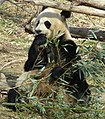Arkivo:Giant Panda Washington DC.JPG

Grandeso de ica previdado: 527 x 600 pixels. Altra qualeso, en pixel-i: 211 x 240 pixels | 422 x 480 pixels | 675 x 768 pixels | 1 174 x 1 336 pixels.
Arkivo originala (1 174 × 1 336 pixel-i, grandeso dil arkivo: 765 KB, MIME type: image/jpeg)
Historio dil arkivo
Kliktez sur la dato/horo por vidar arkivo quale ol aparis ye ta tempo.
| Dato/Horo | Miniaturo | Dimensioni | Uzero | Komento | |
|---|---|---|---|---|---|
| aktuala | 06:48, 7 feb. 2008 |  | 1 174 × 1 336 (765 KB) | Mattflaschen | {{Information |Description={{en|Taken at the en:National Zoo in en:Washington, D.C. The giant panda (Ailuropoda melanoleuca, "black-and-white cat-foot"; Chinese: 大熊貓, Hanyu Pinyin: Dàxióngmāo) is a mammal classified in the bear family, |
Ligilo al imajo
Ca pagini ligas al imajo:
Uzado en altra Wiki
La sequanta Wiki anke uzas ica arkivo:
- Uzado en bbc.wikipedia.org
- Uzado en en.wikipedia.org
- Uzado en hy.wikipedia.org
- Uzado en id.wikipedia.org
- Uzado en ig.wikipedia.org
- Uzado en is.wikipedia.org
- Uzado en it.wikipedia.org
- Uzado en sc.wikipedia.org
- Uzado en ta.wikipedia.org
- Uzado en uz.wikipedia.org
- Uzado en vi.wikipedia.org